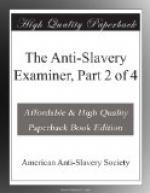The following pages contain the simple and unvarnished story of an AMERICAN SLAVE,—of one, whose situation, in the first place, as a favorite servant in an aristocratic family in Virginia; and afterwards as the sole and confidential driver on a large plantation in Alabama, afforded him rare and peculiar advantages for accurate observation of the practical workings of the system. His intelligence, evident candor, and grateful remembrance of those kindnesses, which in a land of Slavery, made his cup of suffering less bitter; the perfect accordance of his statements, (made at different times, and to different individuals),[B] one with another, as well as those statements themselves, all afford strong confirmation of the truth and accuracy of his story. There seems to have been no effort, on his part to make his picture of Slavery one of entire darkness—he details every thing of a mitigating character which fell under his observation; and even the cruel deception of his master has not rendered him unmindful of his early kindness.
[Footnote B: The reader is referred to JOHN G. WHITTIER, of Philadelphia, or to the following gentlemen, who have heard the whole, or a part of his story, from his own lips: Emmor Kimber, of Kimberton, Pa., Lindley Coates, of Lancaster Co., do.; James Mott, of Philadelphia, Lewis Tappan, Elizur Wright Jun., Rev. Dr. Follen, and James G. Birney, of New York. The latter gentleman, who was a few years ago, a citizen of Alabama, assures us that the statements made to him by James Williams, were such as he had every reason to believe, from his own knowledge of slavery in that State.]
The editor is fully aware that he has not been able to present this affecting narrative in the simplicity and vivid freshness with which it fell from the lips of the narrator. He has, however, as closely as possible, copied his manner, and in many instances his precise language. THE SLAVE HAS SPOKEN FOR HIMSELF. Acting merely as his amanuensis, he has carefully abstained from comments of his own.[A]
[Footnote A: As the narrator was unable to read or write, it is quite possible that the orthography of some of the names of individuals mentioned in his story may not be entirely correct. For instance, the name of his master may have been either Larrimer, or Larrrimore.]
The picture here presented to the people of the free states, is, in many respects, a novel one. We all know something of Virginia and Kentucky Slavery. We have heard of the internal slave trade—the pangs of separation—the slave ship with its “cargo of despair” bound for the New-Orleans market—the weary journey of the chained Coffle to the cotton country. But here, in a great measure, we have lost sight of the victims of avarice and lust. We have not studied the dreadful economy of the cotton plantation, and know but little of the secrets of its unlimited despotism.




